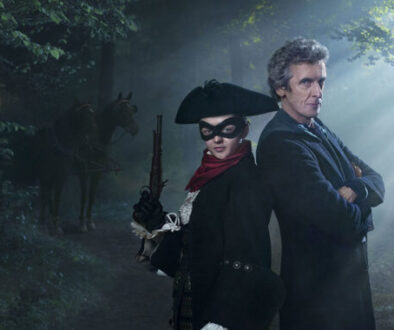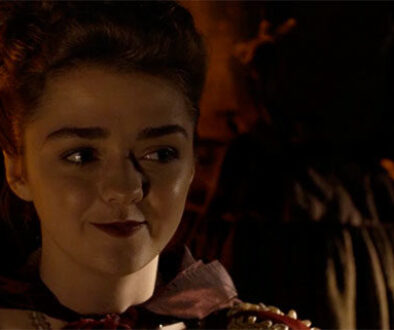The Girl Who Died Review
Clint Hassell gives his verdict on the fifth episode of Series 9.

Have you ever bought a paint by numbers kit? By following the step by step directions you create a painting that, while colorful enough in its own right, somehow isn’t quite as impressive as the masterwork it copies. “The Girl Who Died” is a paint by numbers episode.
Or, maybe a better analogy would be that “The Girl Who Died” is like a recipe. Certainly, all of the ingredients for a standard Doctor Who episode are there:
- Start with a thrilling opening, witty banter, and a questionably “historical” setting.*
- Mix in a minor plot point that conveniently separates the Doctor from the TARDIS.
- Once the Doctor assumes leadership of the group, fold in several obviously-a-stuntman-inside-a-rubber-suit monsters, and a hysterically illogical plot point.**
- Bring the plot to a boil.
- Stir in one stellar guest star and an otherwise forgettable cast.
- Add Moffat-brand timey-wimey to taste.
- Simmer for 45 minutes.
- Season with dodgy effects and references to the canon, and serve with a side of the clever Doctor’s rousing speech.
Humor aside, this is not a complaint. “The Girl Who Died” is comfort food, and normally, the audience eats this stuff up (pun intended). However, having been served soufflé, twice this series, with “The Witch’s Familiar” and “Under the Lake,” this episode feels half-baked.

Perhaps the issue is that the episode’s tone is wildly uneven. In one scene, the Doctor again speaks “baby” – – a lighthearted plot point from Series 6’s “Closing Time” – – only, here, the Doctor seems to translate deeply poignant infant poetry. The scene immediately cuts to a broadly comic training sequence. Certainly, Doctor Who’s unique format allows it to transcend genres. However, unlike, say “Love and Monsters,” which paired absurdist humor and melancholy to portray the isolation of early adulthood, “The Girl Who Died” incorporates so many disparate tone shifts as to suffer from identity crisis.
More likely, the episode feels stale because it repeats several ongoing themes: when confronting Odin, Clara is again presented as very Doctor-ish; the Doctor contemplates his role in weaponizing his companions, and how he has a “duty of care” to protect Clara; she admits that traveling with the Doctor has become her hobby; the Doctor grapples with his conflicting roles as wayward wanderer and Time Lord; the “hybrid” is again mentioned. None of these themes are novel, and none are developed in any meaningful way. They are merely presented again, like reheated leftovers.
Probably the best example of this occurs in the episode’s denouement, as Ashildr is rendered seemingly immortal due to the Doctor’s meddling and alien tech. “Immortality isn’t living forever; that’s not what it feels like,” the Doctor tells Clara. “Immortality is everybody else dying.” Not only is this theme revisited every time the ageless Doctor regenerates or changes companions, it is the main arc of fan favorite Jack Harkness’ storyline. Granted, a guest appearance by Jack would overshadow almost any story, so, for Doctor Who to revisit this concept, a new character almost has to be created. However, knowing that Maisie Williams’ work on Game of Thrones limits her time on Doctor Who to a single adventure, one must question what could possibly be said on the subject in two episodes that hasn’t already been covered in four series of Torchwood. Yes, after 52 years, it is expected that Doctor Who will return to established themes, repackaging them for a new generation. “The Girl Who Died” doesn’t so much present a new take on these story points as it merely restates them.

Worse, “The Girl Who Died” devotes so much time repeating prior narrative elements that it fails to capitalize on or develop plot points actually unique to this episode. For example, though Ashildr explains why she is unwilling to flee from her home and the acceptance she has found there, no mention is made of her feeling guilt at having condemned her village to die in a moment of ill-timed arrogance. A good character study could have been made in Ashildr, a girl with no impulse control, becoming suddenly immortal, perhaps even paralleling her actions to the Doctor’s, who immediately regrets his rash decision to tamper with Ashildr’s right to a natural death.
Further, why exactly does Ashildr die? Ostensibly occurring only to set up “The Woman Who Lived,” Ashildr’s death is absent of thematic progression, irony, or symbolism. There’s not even commentary on the randomness of death. While the Doctor mentions that she died of heart failure because he “used her up like a battery,” there’s no connection to the ongoing theme of the Doctor and Clara’s calloused use of bystanders as pawns. Rather, the incident builds to the revelation that the Doctor is tired of losing people – – a line he says to Clara, no less, in the very first episode that doesn’t directly reference Danny Pink’s recent death.
Certainly, the Doctor needed to face Odin, if only to stop him from plundering other planets, but, why don’t the Vikings leave their village and hide in the woods, as the Doctor suggested? Yes, the episode details their Viking pride and how it dictates they respond to Odin’s challenge, but, in the end, they don’t fight Odin, and they don’t defeat him in battle. Ultimately, the villagers’ behavior is so un-Viking-like that the third act feels slightly contrived.
Still, minor criticisms aside, the episode is . . . fine. Really. It’s a perfectly acceptable filler episode that takes the best parts of a standard adventure and transcribes them into an innocuous romp. As cuisine goes, “The Girl Who Died” is empty calories, and that’s OK, because sometimes, like Rose in “The End of the World,” you just want chips.

* While in Ashildr’s home, the Doctor is seen handling a nicely bound book. Though Vikings did have an alphabet of runes, the vast majority were illiterate. Further, they predated the printing press by at least 400 years. Beyond that, electric eels are native to a small region in South America. Though there is evidence that the Vikings did reach parts of far North America, it is unlikely that Vikings would have had tanks of electric eels in their original Scandinavian homeland. Rather than in Earth’s past, could “The Girl Who Died” have taken place on a distant planet, with Viking-like natives?
** Why, with time of the essence, does Clara stop to teach a stranger how to use the broken sonic glasses, rather than just taking them herself? What is this, “finders keepers”? Had Clara merely grabbed the glasses for herself, only she and the male warriors would have been kidnapped, and Ashildr would never have met, much less challenged Odin.








